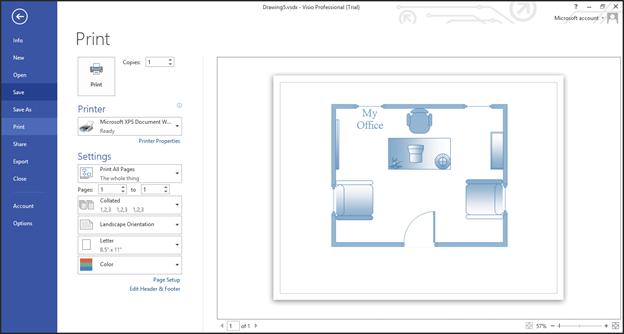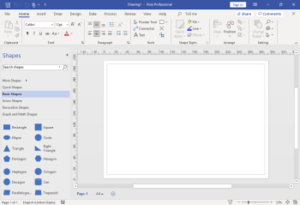By using Microsoft Visio 2013 Viewer, Visio users can freely distribute Visio drawings (files with a.vsdx,.vsdm,.vsd,.vdx,.vdw,.vstx,.vstm,.vst, or.vtx. Microsoft Visio 2013: Altering org chart layout and appearance August 4, 2020 Whether you create an organization chart manually or automatically using the wizard, you might want to modify the appearance and attributes of the org chart shapes after they’re on the page. Microsoft has released an update for Microsoft Visio 2013 64-Bit Edition. This update provides the latest fixes to Microsoft Visio 2013 64-Bit Edition. Additionally, this update contains stability and performance improvements.
In this exercise, you will create a diagram of swimlane same process. By doing this, you will organize the stages of work in lanes based on role to make responsibilities clear.
Note

SET UP Click the File tab, and then click New. Click Flowchart in the Suggested Searches list. Then follow the steps.
- Double-click the Cross-functional Flowchart thumbnail. The orientation selection dialog box opens.
Tip
If you have previously selected a default orientation, this dialog box will not appear again. However, you can still change both the orientation of a single diagram and the default for future diagrams. On the Cross-Functional Flowchart tab, in the Arrange group, click the Orientation button and make your selection.
- Click OK to accept the Horizontal layout option. The CFF add-in places a title band and two swimlanes onto the drawing page.
- On the Cross-Functional Flowchart tab, in the Insert group, click the Swimlane button to add another lane to your diagram.
Tip
There are three other ways to add swimlanes, each of which is useful at various times:
- Right-click the header of an existing lane, and Visio offers you a choice of adding a new swimlane above or below the one you’ve selected.
- Drag a Swimlane shape from the stencil and drop it on top of an existing lane.
- Point to the boundary between lanes, with the cursor just outside the swimlane structure, and click the blue insertion triangle.
- Click the Title bar and type Human Resources Recruiting Swimlane Diagram.
- Click the Function title bar for the top swimlane and type Recruiter.
- Type HR Admin as the title for the second swimlane, and Candidate for the third swimlane.
Tip
You’ve probably already figured this out, but swimlane diagrams are so named because they resemble a swimming pool viewed from above.
Important
The remaining screen shots for this exercise were captured using a black and white theme to improve legibility in the print edition of this book. Your swimlane diagram will continue to show the default theme colors, as seen in the preceding graphic, unless you have changed themes.
- Drag a Swimlane from the Cross-Functional Flowchart stencil but before you drop it onto the page, pause briefly over the boundary between the HR Admin and Candidate swimlanes. An orange insertion bar appears indicating that the lane you drop will be inserted between the two existing lanes.
Note
SEE ALSO Visio 2013 swimlanes are built from a combination of containers and lists.
- Drop the swimlane onto the page, and while it is still selected, type Hiring Manager.
- On the Home tab, in the Tools group, click the Connector button.
Important
If you select a shape with the Connector Tool and then drag another shape onto the page, Visio automatically adds a connector from the first shape to the second. In this exercise, you accomplish this by leaving each shape selected after dragging it onto the page and typing text into it.
You can stop the automatic addition of connectors by deselecting a shape before dragging the next one onto the page. Alternatively, you can select a different shape at any time to change which shapes will be connected automatically.
- Drag a Start/End shape from the Basic Flowchart Shapes stencil onto the drawing page, and use the Dynamic Grid to position it toward the left end of the Hiring Manager lane.
- With the Start/End shape still selected, type Hiring need reported.
Tip
It is not necessary to exit text edit mode before continuing to the next step.
- Drag a Process shape into the HR Admin lane, dropping it above and to the right of the Start/End shape, and then type Log hiring request.
Tip
To fit the shapes for this exercise onto a single page, ensure that the left edge of each new shape you add to the page overlaps horizontally with the preceding shape as shown in the two graphics that follow.
- Draw a connector from the top of the Hiring need reported shape to the left side of the Log hiring request shape.
- Drag a Process shape into the Hiring Manager lane, and then type Prepare job description and screening questions.
- Use the Connector Tool to link the previous process step to your new task.
- Continue adding flowchart shapes to your diagram using the information in rows 4-10 of the following table. (Rows 1-3 represent the shapes you’ve already added.)
Shape Swimlane Shapetext 1 Start/End Hiring Manager Hiring need reported 2 Process HR Admin Log hiring request 3 Process Hiring Manager Prepare job description and screening questions 4 Process HR Admin Advertise open job 5 Process Recruiter Interview candidates 6 Process Hiring Manager Select a candidate 7 Process Recruiter Make job offer 8 Decision Candidate Candidate accepts? 9 Process Recruiter Hire candidate 10 Start/End Hiring Manager End - Add a connector from the Candidate accepts? shape to the bottom of the Select a candidate shape, and then type No.
- Click the connector from the Candidate accepts? shape to the Hire candidate shape and type Yes.
Your swimlane diagram should look something like the following graphic. It’s unlikely that your drawing will look exactly like this one, because you probably made different decisions about placing shapes. However, after the general placement and connectivity are correct, you can adjust and tweak your diagram to make it look the way you’d like.
If you think your diagram is too crowded, realize that the cross-functional flowchart template used the default paper size for your region.
Note

CLEAN UP Save the drawing as HR Recruiting Swimlane, and then close it.
One final note about the Visio 2013 take on cross-functional flowcharts: although the end result looks very much as it has in previous versions of Visio, the underlying structure is very different. In fact, structure is the operative word in the previous sentence. In Visio 2013, each swimlane is a container, and the overall framework is a list.
Whether you create an organization chart manually or automatically using the wizard, you might want to modify the appearance and attributes of the org chart shapes after they’re on the page. Previous versions of Visio allowed you to resize org chart rectangles, adjust spacing, and use more than a dozen alternate layouts.
You can still do all of those things with Visio 2013, but you also have the ability to create radically different looking organization charts if you choose. Visio 2013 includes 10 highly varied org chart styles and more than one hundred new theme-compatible shapes. In addition, the Org Chart tab on the Visio ribbon has been redesigned so that many features that were difficult to find in previous versions are now much more accessible.
You can change the layout of an org chart by using more than a dozen predefined layouts, each of which varies the spacing and connections between shapes. On the Org Chart tab, in the Layout group, click Layout to select from a variety of options.


Tip
Ms Visio 2013 Trial
When the Apply Automatic Layouts to Shape Styles option at the bottom of the layout options list is selected, Visio will re-layout your org chart every time you apply a style. You can retain your current layout when you change styles by clearing the option first.
As an alternative, right-click any shape with subordinates, and then click Arrange Subordinates. Visio opens a dialog box showing all of the built-in layouts.
Tip
If you don’t like the results of any re-layout operation—no matter how radical the changes—you can restore the previous layout with a single undo. Simply type Ctrl+Z or click the Undo button on the Quick Access Toolbar.
Ms Visio 2013 Download Free
If you’ve made manual adjustments to shape position or size, the Re-Layout button, also in the Layout group, will move required shapes to ensure correct positions.
The Best Fit To Page button relocates the entire org chart to better fit on the current page.
You rearrange an organization chart by increasing or decreasing the vertical spacing between shapes or groups of shapes using the Spacing buttons in the Arrange group. Also in the Arrange group, the left and right Move arrows change the horizontal spacing.
If you want to hide some sections of your org chart, select an Executive or Manager shape, and then click Show/Hide Subordinates (you can accomplish the same thing by right-clicking a shape and then clicking Show Subordinates or Hide Subordinates). A Manager shape with hidden subordinates displays an icon in the lower–right corner of the shape to indicate their presence.
The Shapes group contains the Org Chart style gallery that you can use to change the appearance of your chart. From top to bottom, the following graphic shows three of the 10 org chart styles: Belt, Bound, and Stone.
The Shapes group contains buttons that let you adjust the height and width of some or all of the shapes in the org chart; you can select specific shapes to adjust them or click the buttons with no shapes selected to affect all shapes on the page. The final button in the Shapes group lets you convert a shape to a different type of shape, for example, to change a Manager to a Position, or a Vacancy to a Consultant.
Picture
In the following exercise, you’ll import photographs during the process of creating a new organization chart. However, that technique is not the only way to manage org chart photos. The Insert button in the Picture group lets you add one or multiple pictures to an existing organization chart. Additional buttons allow you to change, delete, or show/hide an existing picture. All of these functions can also be performed by right-clicking an org chart shape.
Though themes are located on the Design tab and not the Org Chart tab, don’t forget that all Visio 2013 org chart shapes were designed to accept theme settings. You can apply any range of colors, effects, and embellishments to create exactly the look you want. The three examples in the following graphic use, from top to bottom, the Bound style and the Whisp theme; the Pip style and the Bubble theme; the Coin style and the Organic theme.